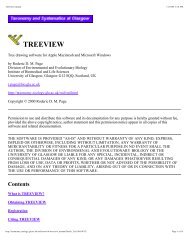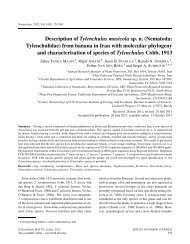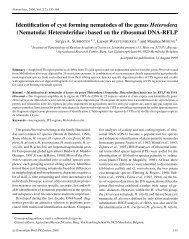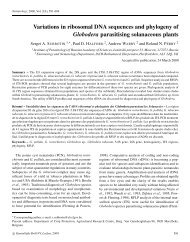Madina Rasulova Molecular Systematics of Nematodes Page 1
Madina Rasulova Molecular Systematics of Nematodes Page 1
Madina Rasulova Molecular Systematics of Nematodes Page 1
Create successful ePaper yourself
Turn your PDF publications into a flip-book with our unique Google optimized e-Paper software.
<strong>of</strong> other species <strong>of</strong> the same genus (BS=100%) as well as only one B.longicaudatus DQ672384. If<br />
considering the first sister clade, it is very well supported: it has one branch supported by 98% which<br />
divides into two clades both <strong>of</strong> which are supported by 100%. The position <strong>of</strong> the studied B.longicaudatus<br />
is exactly the same as in NJ-phylogram.<br />
The phylogenetic tree <strong>of</strong> ML (Figure 7, 10) is exactly the same as <strong>of</strong> MP with only differences in<br />
the percentage by which each branch is supported. The highest BS percentage occurs only in one case: in<br />
one <strong>of</strong> the basal clades (BS=100%). Relatively higher BS is where the clade forms the branch <strong>of</strong> the<br />
studied B.longicaudatus DQ494797 and another one DQ672373, 91% in fact. The supported rate <strong>of</strong> other<br />
branches is very low.<br />
The BI-phylogram (Figure 11) depicts that almost all branches are highly supported: one <strong>of</strong> the<br />
basal clades with consisting <strong>of</strong> Ditylenchus dispaci and Hoplolaimus columbus; in in-group: the clade<br />
comprised <strong>of</strong> species <strong>of</strong> the genus Belonolaimus except B.longicaudatus; the branch with Belonolaimus<br />
sp.; and two small branches consisting only out <strong>of</strong> B.longicaudatus including the studied one are all<br />
supported by 100%. The clade constituted <strong>of</strong> these two small branches is also well supported, 98% in fact.<br />
The position <strong>of</strong> out-groups and the studied B.longicaudatus remains the same as in other phylogenetic<br />
trees.<br />
Though NJ, MP and BI phylograms (Figures 7-11) are not the same by their topology, they have<br />
some clades which remain unchangeable in all types <strong>of</strong> trees which will be described below. Since the<br />
relationships in the out-groups are not completely resolved, it is complicated to indicate which species or<br />
which branch is a basal clade and, thus, all three species are considered as basal clades. Another similarity<br />
is found in the clade consisting <strong>of</strong> only B.longicaudatus species as well as the position <strong>of</strong> the studied one<br />
is constant as well. Besides, other members <strong>of</strong> the genus Belonolaimus are also always gathered in one<br />
clade in all 4 trees. The position <strong>of</strong> other inside clades is rather changeable. Surprisingly, the only one<br />
<strong>Madina</strong> <strong>Rasulova</strong> <strong>Molecular</strong> <strong>Systematics</strong> <strong>of</strong> <strong>Nematodes</strong> <strong>Page</strong> 11
















